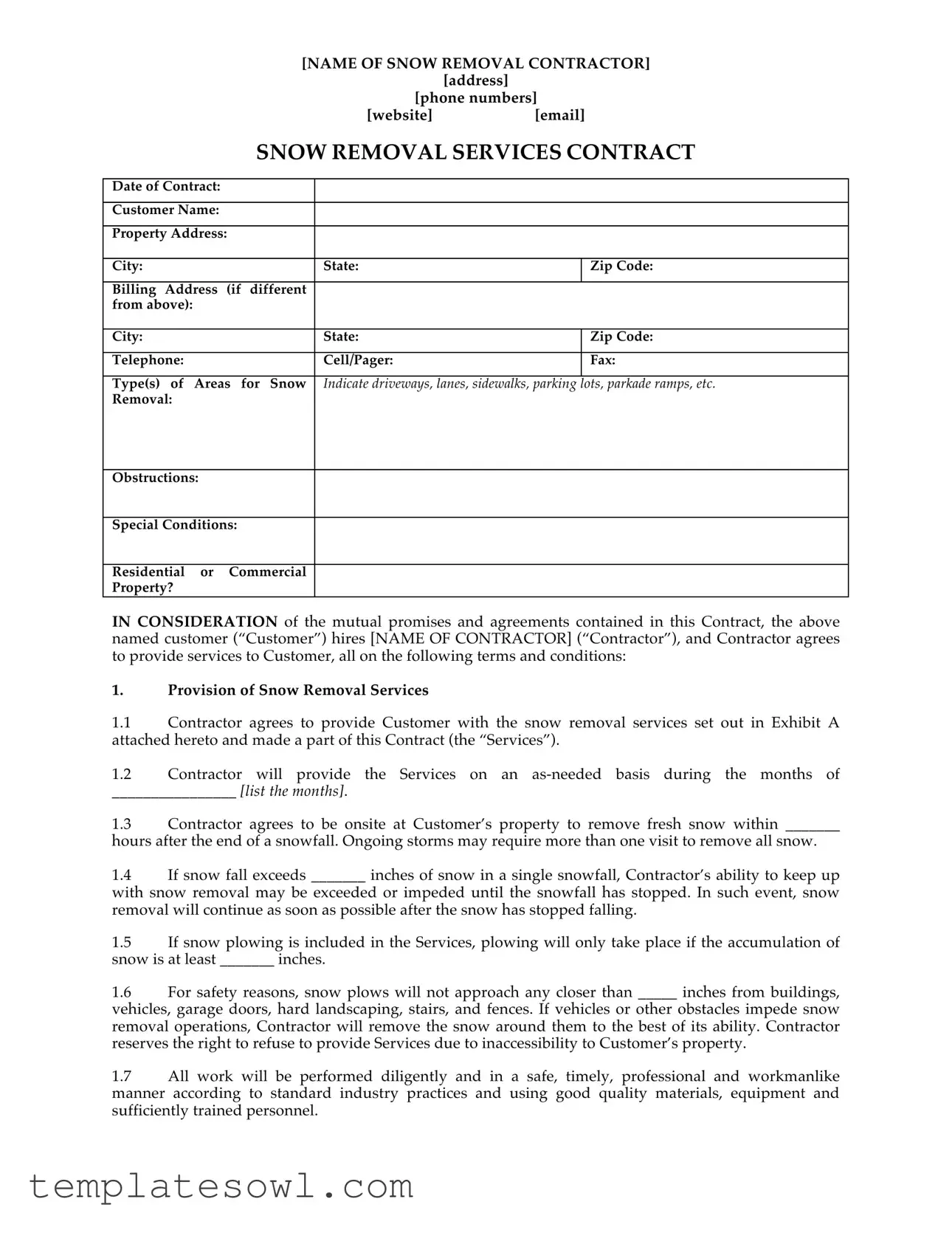|
|
[NAME OF SNOW REMOVAL CONTRACTOR] |
|
|
|
|
[address] |
|
|
|
[phone numbers] |
|
|
|
[website] |
[email] |
|
|
SNOW REMOVAL SERVICES CONTRACT |
|
|
|
|
|
|
Date of Contract: |
|
|
|
|
|
|
|
|
|
|
|
Customer Name: |
|
|
|
|
|
|
|
|
|
|
Property Address: |
|
|
|
|
|
|
|
|
|
|
City: |
|
|
State: |
|
Zip Code: |
|
|
|
|
|
|
Billing Address |
(if |
different |
|
|
|
from above): |
|
|
|
|
|
|
|
|
|
|
|
City: |
|
|
State: |
|
Zip Code: |
|
|
|
|
|
|
Telephone: |
|
|
Cell/Pager: |
|
Fax: |
|
|
|
|
Type(s) of Areas |
for Snow |
Indicate driveways, lanes, sidewalks, parking lots, parkade ramps, etc. |
Removal: |
|
|
|
|
|
|
|
|
|
|
|
Obstructions: |
|
|
|
|
|
|
|
|
|
|
Special Conditions: |
|
|
|
|
|
|
|
|
|
Residential or |
Commercial |
|
|
|
Property? |
|
|
|
|
|
IN CONSIDERATION of the mutual promises and agreements contained in this Contract, the above named customer (“Customer”) hires [NAME OF CONTRACTOR] (“Contractor”), and Contractor agrees to provide services to Customer, all on the following terms and conditions:
1.Provision of Snow Removal Services
1.1Contractor agrees to provide Customer with the snow removal services set out in Exhibit A attached hereto and made a part of this Contract (the “Services”).
1.2Contractor will provide the Services on an as-needed basis during the months of
________________ [list the months].
1.3Contractor agrees to be onsite at Customer’s property to remove fresh snow within _______
hours after the end of a snowfall. Ongoing storms may require more than one visit to remove all snow.
1.4If snow fall exceeds _______ inches of snow in a single snowfall, Contractor’s ability to keep up with snow removal may be exceeded or impeded until the snowfall has stopped. In such event, snow removal will continue as soon as possible after the snow has stopped falling.
1.5If snow plowing is included in the Services, plowing will only take place if the accumulation of snow is at least _______ inches.
1.6For safety reasons, snow plows will not approach any closer than _____ inches from buildings, vehicles, garage doors, hard landscaping, stairs, and fences. If vehicles or other obstacles impede snow removal operations, Contractor will remove the snow around them to the best of its ability. Contractor reserves the right to refuse to provide Services due to inaccessibility to Customer’s property.
1.7All work will be performed diligently and in a safe, timely, professional and workmanlike manner according to standard industry practices and using good quality materials, equipment and sufficiently trained personnel.
- 2 -
2.Term
The term of this Contract is SEASONAL, commencing on the effective date hereof and expiring on
__________ [insert date].
3.Invoicing and Payment
3.1Customer agrees to pay Contractor for the Services in accordance with the rates set out in Exhibit A, to be paid upon receipt of Contractor’s invoice.
3.2Invoices will be submitted [weekly/monthly] by Contractor for payment by Customer. Invoices may be mailed, hand delivered or emailed.
3.3Payment is due upon receipt. Invoices unpaid for more than _____ calendar days after receipt will be marked past due and will bear interest at the rate of ____% per month (___% per year), or the maximum amount allowed by law (whichever is higher), from the due date until paid.
3.4Overdue payments will be applied firstly to accrued interest and secondly to the unpaid principal balance.
3.5If Customer disputes any portion of an invoice, Customer must notify Contractor in writing within ______ calendar days of receiving the said invoice. If no such notification is given, the invoice will be deemed satisfactory. Any portion of an invoice which is not disputed shall be paid in accordance with this Section.
3.6Customer shall be responsible for payment of any attorney’s fees, court costs, or other costs incurred by Contractor in collection of delinquent accounts.
3.7Contractor reserves the right to suspend provision of the Services if payment of invoices is not
current.
THIS IS A 4-PAGE CONTRACT WITH A 1-PAGE SCHEDULE
ATTACHED. GET THE FULL FORM AT www.megadox.com/d/7805.

